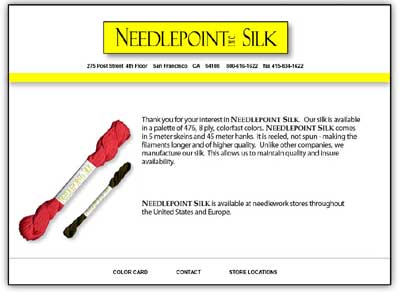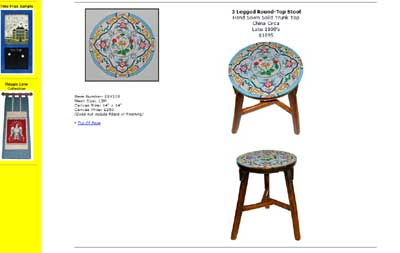One thing I noticed when I was perusing various embroidery shops on the East Coast was that the ones I visited carried the full range of Needlepoint, Inc. Silk. So here’s a little word about this silk thread…
Needlepoint, Inc. is a reeled filament silk (as opposed to a spun silk), which means that the individual fibers that make up the threads are longer and stronger. The luster of a filament silk is also greater than that of a spun silk. The threads are 8-ply, meaning they can be divided into 8 individual threads, and they come in 5 meter skeins (or really large hanks of 45 meters, for those BIG projects!). The company produces its own Chinese silk for its threads; they claim that they therefore have better control over quality and over availability, which makes sense.
What I like about the Needlepoint, Inc. threads is that the shades are carefully graded, so that you can easily select from the color card or the rack a series of colors (say blues, for instance) that will blend into the next lighter or darker shade really nicely.
When comparing the Needlepoint, Inc. silks to Au Ver a Soie’s Soie d’Alger, this is what I found:
1. Needlepoint, Inc., silk is slightly more expensive – averaging around $3.80 – $4.00 / 5 meter skein, whereas Soie d’Alger averages around $3.40 – $3.75.
2. Needlepoint, Inc., silk has one more ply per strand, which means you are getting a little more thread in 5 meters.
3. Needlepoint, Inc., comes in 476 colors, whereas Soie d’Alger comes in over 600 colors.
4. Needlepoint, Inc., is “softer” thread – it does not have the same body as Soie d’Alger, and the twist seems somewhat looser
5. In my opinion, Soie d’Alger has a “richer” sheen to it.
For stitchability, Soie d’Alger always wins out with me. It may be because I’m used to it. I do use a variety of threads, though – and I do like stitching with the Needlepoint, Inc., silks. Still, I seem to get better results, and a smoother stitching experience, with the Soie d’Alger.
If you’re looking for a pretty good silk, I don’t think you can go wrong with the Needlepoint, Inc. silks. Try not to be bothered by their label – it’s bright yellow and can really be a turn-off at first glance (like a whole rack of defective clearance items – not that I have anything against clearance items, but that much yellow on a display of colors is a bit annoying!)

If you want to see what colors they have available, check out the Needlepoint, Inc. color card. You can also browse the Needlepoint, Inc. website for needlework items, primarily (as the name implies) needlepoint. The most intriguing part of the website, in my opinion, is the furniture section – some really ambitious and beautiful stuff in there!

If you want to find out if there’s a store near you that carries Needlepoint, Inc. silk, they have a convenient store locator online as well.
As soon as my camera’s back, I’ll post some photo comparisons!







Can you please tell me how many strands of Needlepoint Inc. Silk to use on 28ct. crossstitch fabric? I’d loved to start my project, but there is no information about this and it is my first time trying silk thread. I’d appreciate your kind reply.
Hi, Pat – I think it would depend on the look you want to achieve. If you want the colors to be very full and the stitching to look heavier, you might be able to get away with 2, but it’ll be somewhat “tight.” One would probably be just right. Can you work a sample area on a little corner patch of your fabric, just to see what 1 strand looks like, then work a little sample patch with 2 strands? Then you’d have a better idea of what look you want to achieve. It also depends a bit on the type of fabric you’re using. If you’re using aida cloth or a looser weave of linen, the holes will be a little more pronounced. If you’re using a linen with plumper threads, more tightly woven, the holes may not be as pronounced, and so your work will be a bit tighter. All that being said, chances are, 1 strand will probably end up being your best bet. Hope that helps! ~MC
I’m beginning The Serenity Prayer by My Big Toe designs. Instructions say I need 70 meters of the primary color. I calculate that I need 70 divided by 5 = 14 skeins. Am I calculating that correctly? Or is each strand 5 meters so I would only need 2 skeins?
Hi, Sue – Thanks for your question! I think your best bet is to contact the designer to hash that out. I don’t want to give you the wrong advice and have you end up short of thread or working from different dye lots. 🙂